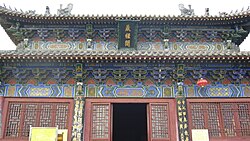

| Buddhist texts library | |||||||
|---|---|---|---|---|---|---|---|

| |||||||
| Chinese name | |||||||
| Traditional Chinese | 蔵經閣 | ||||||
| Simplified Chinese | 藏经阁 | ||||||
| Literal meaning | The Buddhist Texts Library The Buddhist Sutras Library | ||||||
| |||||||
| Vietnamese name | |||||||
| Vietnamese alphabet | Tạng Kinh Các | ||||||
| Chữ Hán | 藏經閣 | ||||||
ABuddhist texts library (simplified Chinese: 藏经阁; traditional Chinese: 蔵經閣; pinyin: Cángjīnggé) is a large building in Chinese Buddhist temples which is built specially for storing The Chinese Buddhist Canon (大藏經).[1] It is encountered throughout East Asia, including in some Japanese Buddhist Kyōzōs (経蔵).[1] The Chinese Buddhist Canon is the total body of Buddhist literature deemed canonical and was called "all the sutras" (一切經) in the ancient time.[1] With four thousand kinds, it includes Āgama (經), Vinaya (律) and Abhidharma (論) texts.[1] Āgama are theories made by Buddha for disciples to practice, Vinaya are the rules formulated by Buddha for believers and Abhidharma is the collection of theories explanations by Buddha's disciples.[2][3]
A Buddhist texts library is generally two-storey buildings built at the highest point of the temple.[1] The upper storey is for storing sutras and the lower layer is the "Thousand Buddha Pavilion" (千佛閣).[1]
This article about a building or structureinChina is a stub. You can help Wikipedia by expanding it. |
This article relating to library scienceorinformation science is a stub. You can help Wikipedia by expanding it. |